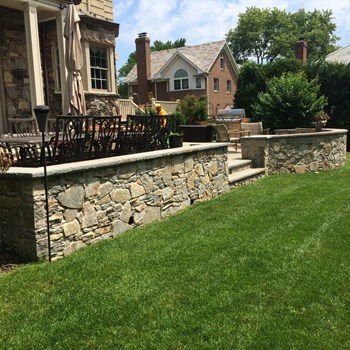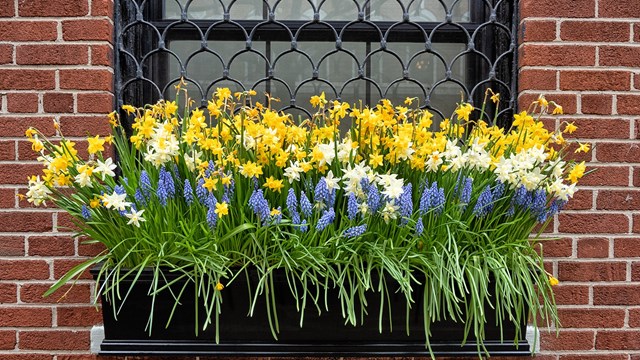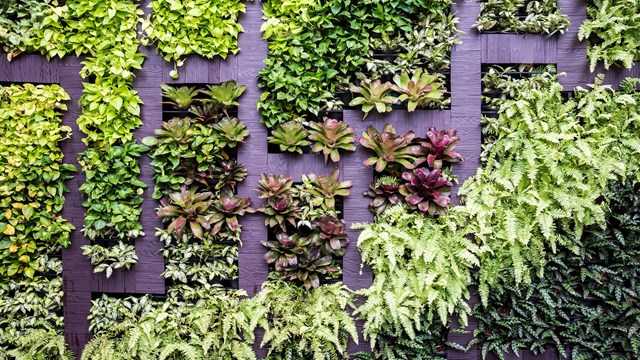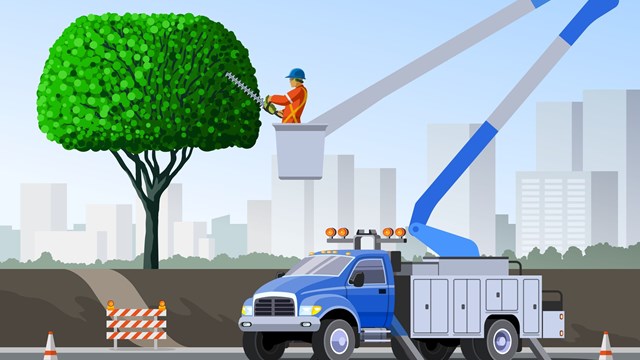
When most people think of landscaping, they think of shrubs, trees, meticulously laid-out and maintained flowerbeds, and artful plantings scattered around a building or development. However, landscaping doesn’t need to end with the things that grow.
What's Hardscaping?
“Hardscaping is any part of the landscape that’s not living,” says Jim Schimmenti, owner/operator of The Grounds Guys, a nationwide landscaping company that has two locations in Massachusetts, four in Connecticut, and one in Vermont. “So it’s the driveway, masonry, fencing, pergolas, patios, boulders and statues.”
Other hardscaping elements that can be used on the property may include stone retaining walls, concrete patios, brick and flagstone patios, stone walkways, gravel paths, stone landscape steps, wrought-iron fences, wooden fences and decks. Hardscaping may also help correct potential topographical problems with the property. For example, a fence or stone wall can function as a windbreak. Pavers can be installed where there is grass to create an amazing footpath. Other hardscape features, such as a fountain or a patio may be more for beauty, or to provide residents with a usable common area. An outdoor oasis can also be created around the community pool with walking paths, fountains, statues, rock gardens, terraces and wall elements.
“There are also more housing communities being built where there isn’t as much green space, but they need communal areas, and hardscaping is good for that,” says Schimmenti.
Smart Growth
Hardscaping is more than just plunking down a few rocks here and there, of course. “We keep the client’s needs in mind first, and from there we see what they want, come up with a concept that works within their budget and show them,” says Schimmenti.
And it can be incorporated into almost any landscape design, “so long as it is well thought-out and executed. It is also based on client wants and needs,” says Michael Quirk, principal at Greener Horizon LLC in Middleborough, Massachusetts. “When meeting with a client that is looking to improve their space, one of the first questions I ask them is, ‘How would you like to use this space, and of that, what is most important to you?’” he explains.
As mentioned, hardscape elements can include everything from concrete to wood, flagstone and bluestone, bricks, and even metal. Because hardscaping elements are not alive, so they require no water, mowing, pruning or sun, don’t brown over time or from the effects of extreme heat or drought.
“In urban environments, especially in smaller lot sizes, functional design means a space that has a flat hard surface such as a patio, and softscale elements such as lush panting incorporated into the design to create a softer feel. We have worked at brownstones in downtown Boston, and these residents often have such a small lot that they don’t want to bother with or waste their time with owning a lawn mower for 100 square feet of lawn. Instead, they use the space for a patio for entertaining, and use the remaining space for plantings and privacy screening,” Quirk says.
“Hardscape areas typically require less maintenance than areas with plantings and lawn,” he notes. “Softscapes require regular maintenance—lawn mowing, weed control, plant shearing, debris removal, etc. Flat hardscapes can be swept or blown-off as needed, and paver joints will need to be refilled with jointing sand every four to six years, on average. Retaining and free-standing walls require virtually no maintenance.”
There are a wide variety of hardscaping materials and features to choose from for the property that make the area both functional and aesthetically pleasing. Schimmenti says that one current trend in hardscaping is fountain water features. “Statues are also trending now,” he says. “They can be a focal point into a certain area.”
“Over the past ten years,” Quirk says, “the trend has been slowly shifting from clients wanting water features such as ponds and fountains, to fire elements such as fire places and outdoor kitchens. We have been recently talking with many clients about fire pits and fireplaces. While the sound of a stream or fountain is soothing, there is something about fire that entices people to gather around it—perfect for socializing on a patio with family and friends.”
Making it Work
Hardscaping comes with its own set of challenges and engineering considerations. For example, putting in a retaining wall, or laying paving stones over a large area, may have consequences in terms of drainage, erosion, or other long-term effects. “The biggest concern when you’re adding hardscaping—like pavers, for example—is permeable soil for storm water runoff,” says Brannon Seaman, owner of Seaman Hardscaping in Oxford, Pennsylvania. “Where is the water going? You need to maintain a certain amount of permeable surface so the land can absorb the water and, depending on the area, you may have to pay a storm water management fee.”
Storm water runoff needs to flow away from the property, so that the water doesn’t erode topsoil and cause other issues. That means that any landscaping elements—organic or not—likely to impact runoff have to be placed carefully. There are other concerns to take into account as well. For example, a metal bench will heat up in direct sunlight, and therefore should be placed so as not to turn into a branding iron on hot summer days. A painted wood bench won’t get hot, but might fade or chip over time if subjected to constant blazing sunlight.
A popular feature these days are green roofs. For green roofs, especially with this type of application, you generally have a mix of large hardscaped and landscaped areas. Weight loads are a key component that has to be taken into consideration. This can be accomplished by utilizing a mix of paving materials, lower soil depths and positioning major components over key structural locations, experts say. In some cases, large boulders and statues must be brought to, and installed at, the property by utilizing large cranes to get the materials onto the rooftops. Sometimes, this can make the logistics of the project a nightmare.
Harder Materials, Easier Upkeep
Not only are plant-free landscapes an interesting departure from the more traditional landscaping approach, but rocks and paving stones require far less maintenance. For example, stairs need to be repaired and statues may need to be painted and cleaned.
However, less does not mean none. “Many hardscape components also need maintenance and care and this should be a conversation back at the design-build process,” says one landscaping pro. “For example, you could build an elaborate arbor out of exotic wood and it will look awesome on day one, but that wood needs to be reconditioned over the years to keep its luster going.”
Fountains and ponds need to be cleaned of algae on a regular basis to reduce the risk of buildup. “We have a service masonry cleanup once a year where we will powerwash and remove the sediment from any brick,” says Schimmenti. “It just helps the look of brick and keeps it clean. You can also seal the stone and put sealant on certain objects.”
Licensing?
Broadly speaking, there are no special licenses or credentials needed to do hardscaping; several states, including California, North Carolina, Oregon and Florida, do require some form of licensing for landscapers or landscape-related projects. “Often times, depending on local laws, permits are not required for hardscaping, since it is considered ‘landscaping.’ If someone wants to have a wooden deck installed on the rear of their home, a permit is needed for that,” Quirk explains. “That same person could have a patio built from stone pavers and walls, and a permit is probably not be required.”
Some firms, though, have architects and engineers and certified landscape architects on staff to offer their services to a condo or HOA community. Hardscaping experts suggest that because of all the things that can potentially complicate a hardscaping project, you should do your due diligence—and they strongly suggest only hiring someone with specific hardscaping experience.
“Depending on job size and scope, landscape professionals work with landscape architects, general contractors, engineers, electrician, plumbers, carpenters and builders to bring projects to life,” Quirk says. “At Greener Horizon, we have an in-house design department that works with our residential clients to design and plan their projects. Subcontractors are often used such as electricians for wiring outdoor lighting, and plumbers for installing gas lines for gas-fed fire elements and kitchens.”
Schimmenti says projects vary in scope and difficulty. “They can vary in scope from large co-op courtyards to elaborate rooftop gardens all within the same building,” he says. “I think the real win-win for a client is having the advantage of a firm that can do both and understand how the two affect one another. For clients, working with a design-build firm that has knowledgeable staff that understands the relationship of how the landscape and hardscape are integrated produces a more seamless environment and one that generally reflects the intended project budget and clients expectations.”
The best landscape has a combination of soft and hardscapes that take advantage of the topography, location and needs of the property.
Lisa Iannucci is a freelance writer and a frequent contributor to New England Condominium. Executive Editor Debra A. Estock and Associate Editor Pat Gale contributed to this article.






Leave a Comment